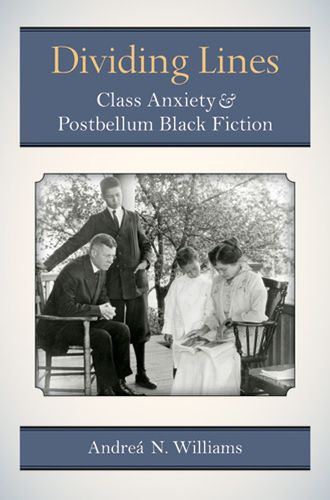Readings Newsletter
Become a Readings Member to make your shopping experience even easier.
Sign in or sign up for free!
You’re not far away from qualifying for FREE standard shipping within Australia
You’ve qualified for FREE standard shipping within Australia
The cart is loading…






One of the most extensive studies of class in 19th-century AfricanAmerican literature to date, Dividing Lines unveils how black fictionwriters represented the uneasy relationship between class differences,racial solidarity, and the quest for civil rights in black communities. Byportraying complex, highly stratified communities with a growing blackmiddle class, these authors dispelled notions that black Americans wereuniformly poor or uncivilized. The book argues that the signs of classanxiety are embedded in postbellum fiction: from the verbal stammeror prim speech of class-conscious characters to fissures in the fiction'sform.
Andrea N. Williams delves into the familiar and lesser-known works ofFrances E. W. Harper, Pauline Hopkins, Charles W. Chesnutt, SuttonGriggs, and Paul Laurence Dunbar, showing how these texts mediateclass through discussions of labor, moral respectability, ancestry, spatialboundaries, and skin complexion. Dividing Lines also draws on readerresponses-from book reviews, editorials, and letters-to show howthe class anxiety expressed in African American fiction directly sparkedreader concerns over the status of black Americans in the U.S. socialorder. Weaving literary history with compelling textual analyses, thisstudy yields new insights about the intersection of race and class in blacknovels and short stories from the 1880s to 1900s.
$9.00 standard shipping within Australia
FREE standard shipping within Australia for orders over $100.00
Express & International shipping calculated at checkout
One of the most extensive studies of class in 19th-century AfricanAmerican literature to date, Dividing Lines unveils how black fictionwriters represented the uneasy relationship between class differences,racial solidarity, and the quest for civil rights in black communities. Byportraying complex, highly stratified communities with a growing blackmiddle class, these authors dispelled notions that black Americans wereuniformly poor or uncivilized. The book argues that the signs of classanxiety are embedded in postbellum fiction: from the verbal stammeror prim speech of class-conscious characters to fissures in the fiction'sform.
Andrea N. Williams delves into the familiar and lesser-known works ofFrances E. W. Harper, Pauline Hopkins, Charles W. Chesnutt, SuttonGriggs, and Paul Laurence Dunbar, showing how these texts mediateclass through discussions of labor, moral respectability, ancestry, spatialboundaries, and skin complexion. Dividing Lines also draws on readerresponses-from book reviews, editorials, and letters-to show howthe class anxiety expressed in African American fiction directly sparkedreader concerns over the status of black Americans in the U.S. socialorder. Weaving literary history with compelling textual analyses, thisstudy yields new insights about the intersection of race and class in blacknovels and short stories from the 1880s to 1900s.